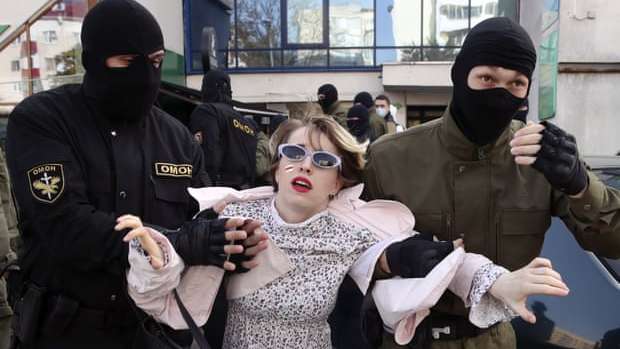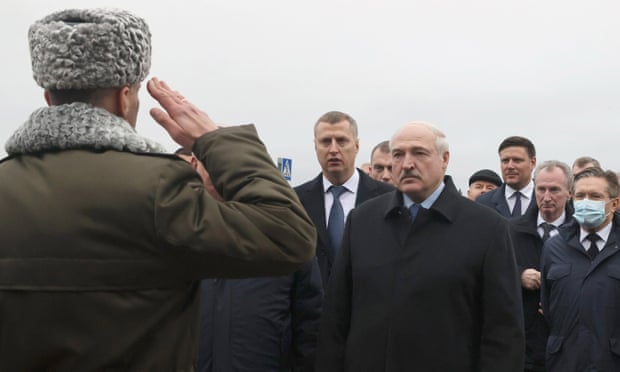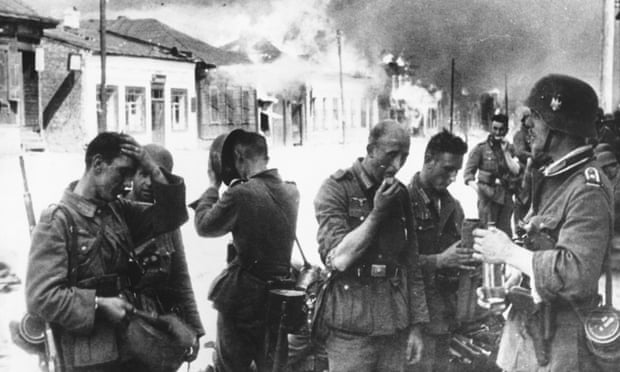‘Crush the fascist vermin’: Belarus opposition summons wartime spirit
The Guardian
10 November 2020, 14:32
 Partisan tactics once used to fight the Nazis have been turned against Alexander Lukashenko’s brutally repressive regime
Partisan tactics once used to fight the Nazis have been turned against Alexander Lukashenko’s brutally repressive regime
In Minsk, what people here call the Great Patriotic War is never far away. Monuments, street names and museums venerate the memory of the awful years from 1941 to 1945, when the Soviet Union was at war with Nazi Germany.
Alexander Lukashenko, who has ruled Belarus since 1994, has used the years of partisan resistance against the Nazi occupation of the country, and the eventual victory by the Red Army, as the basis for a neo-Soviet, Belarusian identity.
But in recent months, something strange has happened, as Lukashenko faces angry and sustained protests to his continued rule and has launched a vicious crackdown. The war narrative that his regime has done so much to promote still resonates among the population, but with a twist: now, his authorities have become the Nazis.
It has become normal for people to speak about the authorities as “fascists” and “occupiers” who remain in power only due to their military and police might.
Given some of the images that came from the crackdown in August, it is not hard to see why: thousands of Belarusians were subjected to ritual beatings and abuse from security officers dressed in black and wearing balaclavas; military vehicles patrol the streets; and anyone supporting the opposition movement can be snatched for interrogation at any moment.
“We were brought up on endless films and books about fighting the fascists, and then, when you look at the uniforms, the style, the methods used by the authorities, it’s not hard to see why these memories resonated,” said Yulia Chernyavskaya, a Belarusian cultural anthropologist.
Under Lukashenko, the war has been the centrepiece of school history teaching and the focus of hundreds of monuments and museums. The country’s independence day is celebrated on the day Minsk was liberated from the Nazis in 1944, not on the day Belarus actually achieved independence from the Soviet Union.
“We will expand this space to raise new patriots who are able to defend not only themselves, their family and children, but also their country,” said Lukashenko on a visit earlier this year to the Stalin Line, a museum complex outside Minsk where visitors can see bunkers from a defensive line built by the Soviet Union in the 1930s, ride on tanks and get tours from guides in Red Army uniforms.
![‘Crush the fascist vermin’: Belarus opposition summons wartime spirit]()
In 2014, Lukashenko and Russian president Vladimir Putin re-opened Minsk’s main second world war museum, updated for the 21st century. Putin has also used the war victory as the basis for a new Russian identity. Belarus, unlike most of the Soviet Union, spent the majority of the war under occupation, and here, the memories and veneration of the local partisan movement, which fought against the Nazi occupiers and local collaborators, are strong.
One example of protesters drawing on this legacy in the fight against Lukashenko is Vozhyk, a one-page A4 pamphlet of anti-regime caricatures and satirical articles. Vozhyk was a wartime partisan leaflet that was originally called “Crush the fascist vermin”; now, it is released in digital form on an encrypted Telegram channel, and comes with the following message to would-be distributors: “Partisans! Download the PDF, print it out, and stick it in your apartment entrance … We are the majority and together we will win!”
One of the editors of Vozhyk, who wished to remain anonymous, said she had chosen the name because of the resonance with the war period: “The authorities are monsters and they fit the definition of fascism. During the August violence, it was incredible how people were surviving: they went out, came home, had a quick sleep and then went out again. The partisan gene is alive in all of us.”
It is true that almost overnight, tens of thousands of Belarusians acquired their own white-red-white flag, which had been effectively banned for the past two decades. Groups on the app Telegram have sprung up to organise the protest in individual towns, streets or apartment blocks, with the participants often using conspiratorial methods to shield their identities from each other, so that if one gets caught by authorities, they will not be able to give the others away. In short: a modern partisan movement sprang up in a matter of weeks.
![]()
Lukashenko’s supporters claim they can’t see the parallels. “Lukashenko has helped a lot of people, people here have good lives, and they are crying about fascists. What fascists?” said Alexander Metla, who runs the Stalin Line complex. Tens of thousands of school pupils and other visitors each year watch military reconstructions and relive a heroised version of the war effort at the complex, which features a bust of Stalin and a large photograph of Lukashenko in military uniform at the entrance.
For their part, the authorities have tried to show that it is the protesters who are the descendants of the Nazis, pointing out that the white-red-white flag was used by Nazi collaborators (but ignoring its longer history). During the weekly Sunday protests, the army guards the second world war museum with barbed wire and a row of armed troops. Defence minister Viktor Khrenin said rallies using the white-red-white flag in such “sacred places” would be dealt with firmly by the army.
Such rhetoric worked well in Ukraine in 2014, when the Kremlin portrayed the Maidan revolution in Kyiv as a “fascist coup” and backed a separatist movement in the country’s east that rallied behind Soviet second world war symbolism. Using the same playbook has not had the same effect in Belarus, however. Partly because far-right nationalists simply do not exist in Belarus, and partly down to the sheer brutality of Lukashenko’s crackdown and the courage of those who continue to stand up against it.
“We always laughed at this stereotype of the Belarusians as partisans as if it was nonsense, but it was really quite surprising how people suddenly acquired these tactics as if they knew it from their birth,” said Chernyavskaya.
10 November 2020, 14:32

Military police detain a woman at an opposition protest in Minsk, one of many demonstrations that followed the August election. Photograph: Natalia Fedosenko/TASS
In Minsk, what people here call the Great Patriotic War is never far away. Monuments, street names and museums venerate the memory of the awful years from 1941 to 1945, when the Soviet Union was at war with Nazi Germany.
Alexander Lukashenko, who has ruled Belarus since 1994, has used the years of partisan resistance against the Nazi occupation of the country, and the eventual victory by the Red Army, as the basis for a neo-Soviet, Belarusian identity.
But in recent months, something strange has happened, as Lukashenko faces angry and sustained protests to his continued rule and has launched a vicious crackdown. The war narrative that his regime has done so much to promote still resonates among the population, but with a twist: now, his authorities have become the Nazis.
It has become normal for people to speak about the authorities as “fascists” and “occupiers” who remain in power only due to their military and police might.
Given some of the images that came from the crackdown in August, it is not hard to see why: thousands of Belarusians were subjected to ritual beatings and abuse from security officers dressed in black and wearing balaclavas; military vehicles patrol the streets; and anyone supporting the opposition movement can be snatched for interrogation at any moment.
“We were brought up on endless films and books about fighting the fascists, and then, when you look at the uniforms, the style, the methods used by the authorities, it’s not hard to see why these memories resonated,” said Yulia Chernyavskaya, a Belarusian cultural anthropologist.
Under Lukashenko, the war has been the centrepiece of school history teaching and the focus of hundreds of monuments and museums. The country’s independence day is celebrated on the day Minsk was liberated from the Nazis in 1944, not on the day Belarus actually achieved independence from the Soviet Union.
“We will expand this space to raise new patriots who are able to defend not only themselves, their family and children, but also their country,” said Lukashenko on a visit earlier this year to the Stalin Line, a museum complex outside Minsk where visitors can see bunkers from a defensive line built by the Soviet Union in the 1930s, ride on tanks and get tours from guides in Red Army uniforms.

President Alexander Lukashenko at the opening earlier this month of Belarus’s first nuclear power station. Photograph: Nikolai Petrov/EPA
In 2014, Lukashenko and Russian president Vladimir Putin re-opened Minsk’s main second world war museum, updated for the 21st century. Putin has also used the war victory as the basis for a new Russian identity. Belarus, unlike most of the Soviet Union, spent the majority of the war under occupation, and here, the memories and veneration of the local partisan movement, which fought against the Nazi occupiers and local collaborators, are strong.
One example of protesters drawing on this legacy in the fight against Lukashenko is Vozhyk, a one-page A4 pamphlet of anti-regime caricatures and satirical articles. Vozhyk was a wartime partisan leaflet that was originally called “Crush the fascist vermin”; now, it is released in digital form on an encrypted Telegram channel, and comes with the following message to would-be distributors: “Partisans! Download the PDF, print it out, and stick it in your apartment entrance … We are the majority and together we will win!”
One of the editors of Vozhyk, who wished to remain anonymous, said she had chosen the name because of the resonance with the war period: “The authorities are monsters and they fit the definition of fascism. During the August violence, it was incredible how people were surviving: they went out, came home, had a quick sleep and then went out again. The partisan gene is alive in all of us.”
It is true that almost overnight, tens of thousands of Belarusians acquired their own white-red-white flag, which had been effectively banned for the past two decades. Groups on the app Telegram have sprung up to organise the protest in individual towns, streets or apartment blocks, with the participants often using conspiratorial methods to shield their identities from each other, so that if one gets caught by authorities, they will not be able to give the others away. In short: a modern partisan movement sprang up in a matter of weeks.

German troops enter the burning ruins of Vitebsk, now in north-east Belarus, in August 1941. Photograph: Hulton Deutsch/Corbis/Getty Images
Lukashenko’s supporters claim they can’t see the parallels. “Lukashenko has helped a lot of people, people here have good lives, and they are crying about fascists. What fascists?” said Alexander Metla, who runs the Stalin Line complex. Tens of thousands of school pupils and other visitors each year watch military reconstructions and relive a heroised version of the war effort at the complex, which features a bust of Stalin and a large photograph of Lukashenko in military uniform at the entrance.
For their part, the authorities have tried to show that it is the protesters who are the descendants of the Nazis, pointing out that the white-red-white flag was used by Nazi collaborators (but ignoring its longer history). During the weekly Sunday protests, the army guards the second world war museum with barbed wire and a row of armed troops. Defence minister Viktor Khrenin said rallies using the white-red-white flag in such “sacred places” would be dealt with firmly by the army.
Such rhetoric worked well in Ukraine in 2014, when the Kremlin portrayed the Maidan revolution in Kyiv as a “fascist coup” and backed a separatist movement in the country’s east that rallied behind Soviet second world war symbolism. Using the same playbook has not had the same effect in Belarus, however. Partly because far-right nationalists simply do not exist in Belarus, and partly down to the sheer brutality of Lukashenko’s crackdown and the courage of those who continue to stand up against it.
“We always laughed at this stereotype of the Belarusians as partisans as if it was nonsense, but it was really quite surprising how people suddenly acquired these tactics as if they knew it from their birth,” said Chernyavskaya.

